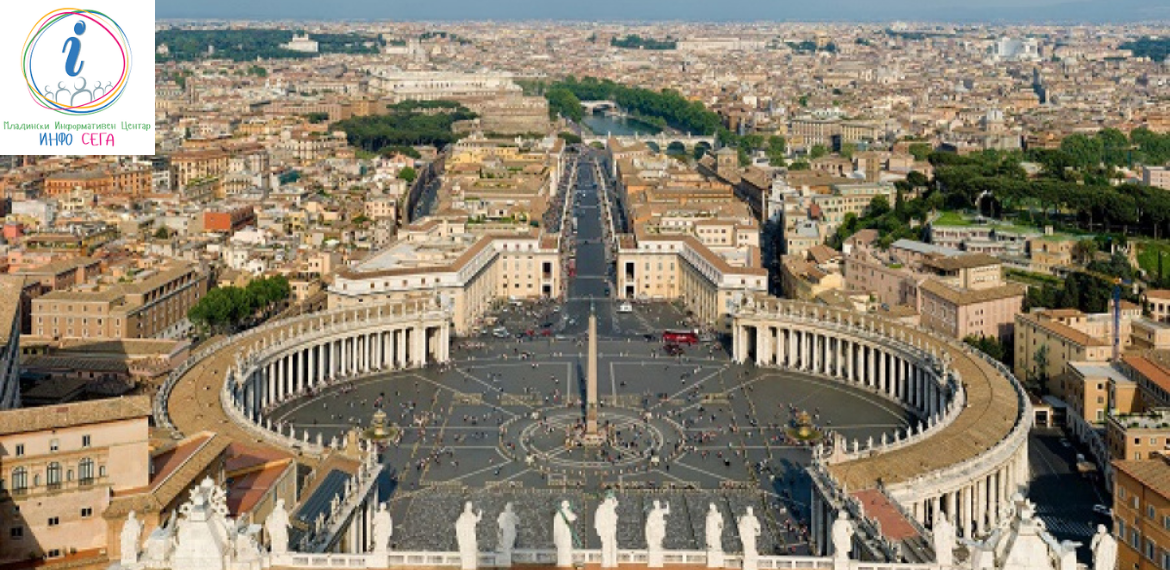
A reading journey through some interesting countries in the world - The Vatican
As young people, our desire to travel, the entire world far and wide, is very much understandable.
Whether we want to travel to meet new and interesting people or for the shear passion of sight –seeing and picturesque views, in the modern increasingly globalized and shrinking world, the opportunities to do so, are getting closer and closer, and it is getting easier for us to be able to visit all these interesting places that we always dreamed of.
Here we will start a series of articles about some of the most interesting countries in the world, and what are the facts that we should we know about them, why not even, before visiting maybe. Some of these countries (err, should we say most of these countries) maybe we didn’t had the opportunity to visit yet, but still through some reading and some research on the always reliable source of information - the world wide web, we can get as close to these places as possible, through the silver screen of our computers, and get at least a remote feeling of their atmosphere.
What a better place to start our journey through the world, than the capital of the Catholic Church,and place of residence ofthe bishop of Rome , which is also one amongst his eight official titles, His Holiness pope Francis I, or namely the Vatican City.
The Vatican Is also owner of some of the world’s most impressive collections of art and history all contained within the borders of the world’s smallest country, the entirety of which you can cover by foot for only 40 minutes.
Of course we wonder, how come, this “gated community” sized country has become the world’s smallest state?!?
What we find out is that there are two possible answers to this question. The first and shorter one is simple – because of the Italian WW2 era dictator – Benito Mussolini. And the second one is very much complicated and longer, as it involves thousands of years of the history of Italy, and the Vatican state itself. So maybe, what we want to learn is the simplified medium-sized version. Without mentioning all the details, as we want to save them for our inevitable visitation to this amazing, and for many, even holy place.
In the medieval period, the popes used to rule a country called the Papal States that covered much of modern Italy. It was during this more than thousand year reign, that the Popes constructed the St. Peter’s Basilica – the largest church in the world – and also built a wall around the base of the hill in Rome, known as the Vatican, upon which hill st.Peter reportedly himself stood. But the kingdom of Italy next door thought that Rome would make an awesome capital for their country, and so conquered the Papal States.
With his nation destroyed, the Pope hid behind the walls of the Vatican and conflictingly refused to acknowledge the existence of the kingdom of Italy, while simultaneously complaining that he is being held a prisoner by the same kingdom. Rather than risking a religious civil war by getting rid of the pope, the Kingdom of Italy decided to wait him out, assuming that he would eventually give up – but religion is nothing if not obstinate, so five Popes and sixty years later nothing had changed.
Which now brings us to Benito Mussolini, the then prime minister of Italy, who was tired of listening to the Pope complaining to the Italian Catholics about his self- imposed imprisonment so Mussolini thought he could score some political points by striking a deal which looked like this:
First, Italy gave the land of Vatican to the Pope.
And second, Italy gave the Pope a bunch of apology money.
In return the Pope had to acknowledge that Italy existed and second, the Pope promised to remain neutral in politics and wars. – On the off chance that, you know, Mussolini thought war might become a real a thing.
The deal was signed and a new country, the Vatican City was born. And today the tiny nation on a hill has all the things you’d expect of a country: its own government that makes its own laws that are enforced by its own police, who put people who broke them in its own jail. It also has it’s own bank and prints its own stamps and issues its own license plates, though only its own citizens can drive within its borders presumably because of terrible, terrible parking conditions, and as a true mark of any self- respecting nation: it has its own top level domain: .VA
But despite all these national trappings Vatican City is not really like any other country.
So let’s hold on to our fancy bishop hats, because the things are about to get really interesting.
To understand the Vatican, there are two people and two things that we need to know about; the famous Pope, the incredibly confusing Holy See, The Country of the Vatican City and along with that the almost completely unknown King of the Vatican City.
But first the Pope, who gets a throne to sit upon and from which he acts like the Bishop for all the Catholics in Rome. Actually all the Bishops in the Catholic Church get their own thrones but because the Bishop of Rome is also the Pope, his throne is special and has it’s own special name: The Holy See. Every time the Pope dies or retires there is a sort of game of thrones to see which of the bishops will next get to occupy the Holy See. So while the popes come and go, the throne is eternal. As such the name “The Holy See” not only refers to the throne but also all the rules that make the Catholic Church the Catholic Church.
When Mussolini crafted that aforementioned deal, technically he gave the land of Vatican city to the Holy See, which, believe it or not, is a legal corporate person in international law. Basically every time you hear (or read) the words “The Holy See” think Catholic Church incorporated (inc.) of which the Pope is the CEO.
Now back to the King.
The king of Vatican City has absolute, unchecked power within the country’s borders and his presence makes the Vatican City one of the only six remaining absolute monarchies in the world, including Brunei, Qatar, Oman, Saudi Arabia and Swaziland. The King’s absolute power is why Vatican City can’t join the European Union, because only democracies are allowed. Though the Vatican City does, strictly speaking have a legislative branch of government, staffed by cardinals, appointed by the Pope, the king of Vatican City can overrule their decisions at every time and for any reason.
So why do you never hear about the King of the Vatican City?
Because though King and Pope are two different roles, they just happen to be occupied by the same person at the same time, which has the funny consequence that, because the Pope is elected and the King is all- powerful, but they’re the same guy, it makes the Vatican City the world’s only elected, non- hereditary absolute monarchy.
It’s this dual role that makes untangling the Vatican City so difficult because the Pope, depending on the situation either acts as The King of the country of Vatican City or the Pope of the Holy See.
If it is a bit hard to understand here is an analogy. – Imagine if a powerful international company say “Green Industries” had a CEO who convinced the United States to give one of its islands to the company which then made the island into a new country – i.e. “Greentropolis”, with an absolute monarchy as its government and the law that the king of “Greentropolis” is by definition, the CEO of Green Industries. It is pretty obvious at this point that the CEO should move his corporate headquarters to the new nation, so that the laws of the country can benefit the company and the company’s global reach can benefit the country. As for the man in the middle, sometimes it’s good to be the CEO and sometimes it is good to be the King. That is essentially the Vatican City. But if you’re still confused, don’t worry even other countries can’t keep it straight. For example the United Nations has the Holy See, the corporation, as a member but not, Vatican City, the actual country. And the Holy See gives passports to Vatican City citizens that other countries accept even though these passports come from a company and not a country.
And speaking of the Vatican City citizens they are perhaps the strangest consequence of the Pope’s dual role as religious leader and monarch. While other countries mint new citizens with the ever popular process of human reproduction. Vatican City does not. No one in Vatican City is born a citizen, and that’s not just because, within a rounding error, there are no female Vaticans. The only way to become a citizen of the Vatican City is for the King of the Vatican City to appoint you as one. And the King only appoints you as a citizen if you work for the Pope – who is also the King. And because the King is all-powerful your citizenship is at his whim. If you quit your job for the Pope, the King – who is also the Pope, will revoke your citizenship! These rules mean that the Vatican City does not have a real permanent population to speak of:
there are about 500 full citizens, which is fewer people that live in a single Skyscraper in many countries, and all these citizens work for the Holy See as either Cardinals or Diplomats or the Pope’s bodyguards or other Catholic- related jobs.
So it’s best to think of the Vatican City as a kind of sovereign corporate headquarters that grants temporary citizenship to its managers rather than a real city- state like Singapore: which has a self- reproducing population of citizens, engaged in a variety of economic activities, both of which Vatican City lacks. But in the end, the reason the world cares about the Vatican City is not because of the citizens within its walls, but because of the billion members of its church outside those walls. Most of which probably, are totally clueless about the interesting system under which the city- state home of their spiritual leader came to be or is functioning even in the present times.
Written and summarized by: Velin Nedkov

